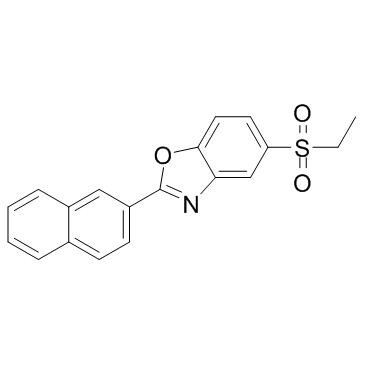
Ezutromid
CAS No. 945531-77-1
Ezutromid( SMT-C1100 | VOX-C1100 | BMN-195 )
Catalog No. M16772 CAS No. 945531-77-1
The first orally bioavailable small molecule utrophin upregulator.
Purity : >98% (HPLC)
 COA
COA
 Datasheet
Datasheet
 HNMR
HNMR
 HPLC
HPLC
 MSDS
MSDS
 Handing Instructions
Handing Instructions
| Size | Price / USD | Stock | Quantity |
| 2MG | 43 | In Stock |


|
| 5MG | 72 | In Stock |


|
| 10MG | 115 | In Stock |


|
| 25MG | 237 | In Stock |


|
| 50MG | 380 | In Stock |


|
| 100MG | 610 | In Stock |


|
| 500MG | 1242 | In Stock |


|
| 1G | Get Quote | In Stock |


|
Biological Information
-
Product NameEzutromid
-
NoteResearch use only, not for human use.
-
Brief DescriptionThe first orally bioavailable small molecule utrophin upregulator.
-
DescriptionThe first orally bioavailable small molecule utrophin upregulator; demonstrates significant disease modifying effects in DMD models; reduces a number of the pathological effects of dystrophin deficiency, results in reduced pathology, better muscle physiology leading to an increase in overall strength, and an ability to resist fatigue after forced exercise.(In Vitro):Ezutromid induces increased levels of utrophin RNA in human muscle cells. Treatment of human DMD cells with Ezutromid lead to a 2-fold increase in utrophin protein levels at an optimal concentration of 0.3 uM after 3 days of treatment. Ezutromid was safe and well tolerated with plasma concentrations achieved suf cient to cause a 50% increase in concentrations of utrophin in cells. Ezutromid led to a 30% increase in Utrn mRNA level and resulted in a 2.0-fold increase in UTRN protein level.(In Vivo):Note: You can dissolve the products in phosphate buffered saline (PBS), 0.1% Tween-20, 5% DMSO).
-
In VitroEzutromid induces increased levels of utrophin RNA in human muscle cells. Treatment of human DMD cells with Ezutromid lead to a 2-fold increase in utrophin protein levels at an optimal concentration of 0.3 uM after 3 days of treatment. Ezutromid was safe and well tolerated with plasma concentrations achieved suf cient to cause a 50% increase in concentrations of utrophin in cells.Ezutromid led to a 30% increase in Utrn mRNA level and resulted in a 2.0-fold increase in UTRN protein level.
-
In VivoNote: You can dissolve the products in phosphate buffered saline (PBS), 0.1% Tween-20, 5% DMSO) .
-
SynonymsSMT-C1100 | VOX-C1100 | BMN-195
-
PathwayOthers
-
TargetOther Targets
-
RecptorOthers
-
Research AreaOther Indications
-
IndicationOther Disease
Chemical Information
-
CAS Number945531-77-1
-
Formula Weight337.3923
-
Molecular FormulaC19H15NO3S
-
Purity>98% (HPLC)
-
SolubilityDMSO: 10 mg/mL
-
SMILESO=S(C1=CC=C(OC(C2=CC=C3C=CC=CC3=C2)=N4)C4=C1)(CC)=O
-
Chemical NameBenzoxazole, 5-(ethylsulfonyl)-2-(2-naphthalenyl)-
Shipping & Storage Information
-
Storage(-20℃)
-
ShippingWith Ice Pack
-
Stability≥ 2 years
Reference
1. Tinsley JM, et al. PLoS One. 2011 May 6;6(5):e19189.
2. Tinsley J, et al. J Clin Pharmacol. 2015 Jun;55(6):698-707.
molnova catalog



related products
-
FITC-Dextran
FITC-Dextran (MW 10000) is a marker consisting of coupling fluorescein-isothiocyanate to dextran (10 kDa).
-
Tigloylgomisin O
Tigloylgomisin O is a natural product for research related to life sciences.
-
2,3-Didehydrosomnife...
2,3-Didehydrosomnifericin is a natural product.



 Cart
Cart
 sales@molnova.com
sales@molnova.com


